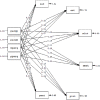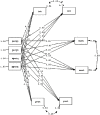Incremental Validity and Informant Effect from a Multi-Method Perspective: Assessing Relations between Parental Acceptance and Children's Behavioral Problems
- PMID: 27242582
- PMCID: PMC4861845
- DOI: 10.3389/fpsyg.2016.00664
Incremental Validity and Informant Effect from a Multi-Method Perspective: Assessing Relations between Parental Acceptance and Children's Behavioral Problems
Abstract
This study examines the relationships between perceived parental acceptance and children's behavioral problems (externalizing and internalizing) from a multi-informant perspective. Using mothers, fathers, and children as sources of information, we explore the informant effect and incremental validity. The sample was composed of 681 participants (227 children, 227 fathers, and 227 mothers). Children's (40% boys) ages ranged from 9 to 17 years (M = 12.52, SD = 1.81). Parents and children completed both the Parental Acceptance Rejection/Control Questionnaire (PARQ/Control) and the check list of the Achenbach System of Empirically Based Assessment (ASEBA). Statistical analyses were based on the correlated uniqueness multitrait-multimethod matrix (model MTMM) by structural equations and different hierarchical regression analyses. Results showed a significant informant effect and a different incremental validity related to which combination of sources was considered. A multi-informant perspective rather than a single one increased the predictive value. Our results suggest that mother-father or child-father combinations seem to be the best way to optimize the multi-informant method in order to predict children's behavioral problems based on perceived parental acceptance.
Keywords: behavioral problems; children; hierarchical regression; incremental validity; informant effect; multiple informants; parental acceptance-rejection; structural equations models.
Figures


References
-
- Achenbach T. M. (2006). As others see us: clinical and research implications of cross-informant correlations for psychopathology. Curr. Dir. Psychol. Sci. 15 94–98. 10.1111/j.0963-7214.2006.00414.x - DOI
-
- Achenbach T. M., Rescorla L. A. (2007). Multicultural Supplement to the Manual for the ASEBA: School-Age Forms & Profiles. Burlington, VT: University of Vermont, Research Center for Children, Youth, and Families.
LinkOut - more resources
Full Text Sources
Other Literature Sources

